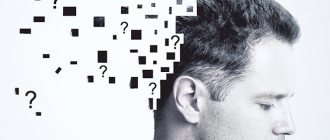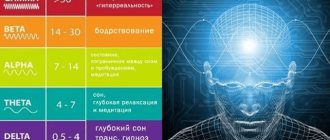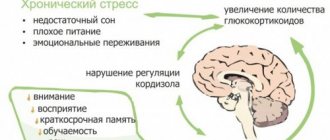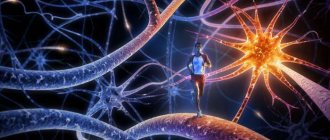Why does the brain get tired?
All brain functions are regulated by inhibitory and excitatory systems, each of which is responsible for the functioning of its departments. When both systems are in balance, a person is full of strength and energy. If the inhibitory system begins to dominate, mental fatigue appears. Its symptoms are decreased performance, concentration and memory.
In Maxim Dorofeev’s book “Jedi Techniques,” the level of mental energy responsible for brain activity is called “thought fuel”:
“Thought fuel” is a supply of a certain resource necessary for the work of slow thinking (as well as for self-control).”
When the level of “thought fuel” is low, even the simplest tasks are solved slowly. Procrastination and laziness appear, which are actually a consequence of depletion of mental resources.
When Emotional Problems Arise
Emotions are needed to help us survive in a world where we depend on other people. Over time, the limbic brain has evolved to automatically create emotions such as anger and sadness, which help us navigate society.
When someone treats us badly, we are evolutionarily programmed to get angry in order to try to change that person's behavior. When we are rejected, we feel sad about the loss of what we wanted from someone else and move on.
However, in childhood, when our survival is especially dependent on others, their reactions (in particular, parents) to our emotions either help us in the future to adapt normally in society, or develop painful reactions.
For example, if a child is angry at being treated unfairly and is punished for it, over time he will begin to unconsciously associate the expression of anger with pain. And when something unfair happens, such a person will feel anxiety about his anger instead of anger, because he has learned from his environment that anger brings pain and does not help protect himself.
The limbic system tries to prevent more emotional pain from punishment, but the person pays for this with constant anxiety. This becomes especially problematic when people enter new relationships (friendships, romantic relationships) in which open expression of anger is possible, but early experiences cause the person to hold back anger and experience anxiety.
Where is the “thought fuel” lost?
According to a study conducted by David Meyer, Ph.D., of the American Psychological Association, even briefly switching to another task while working on the main one reduces productivity by 40 percent.
Multitasking here means not only solving work issues, but also any other actions.
Scrolling through Instagram feeds or watching funny videos on Youtube are also tasks, and no less mental resources are spent on them than on checking students’ notebooks. Thus, social networks and surfing the Internet cannot be considered as a “reboot” for the brain.
Another reason for mental fatigue is a large number of unfinished tasks. According to the “unfinished business concept,” developed by Soviet psychologist Bluma Zeigarnik, the brain constantly keeps such things and actions in mind (“Zeigarnik effect”) and, as a result, cannot relax, creating constant internal tension.
Deception #2: We only use 10% of our brain
We have all heard about this myth. Some people first heard about it in school, while others heard about it from a friend. Some may have learned about it from the media - maybe it was a TV show, or maybe a documentary or feature film. This myth is usually used to highlight what amazing possibilities remain untapped: if only we could access the rest of our brain, what heights could we achieve?
The roots of this story go back to several sources at once, but, as often happens when some kind of public opinion is formed, it is a consequence of a whole chain of events. Some attribute this theory to the writer and philosopher William James, who wrote in his book Human Energy: “We use only a small part of our mental and physical resources.” Or it could have started with the work of French physicist Pierre Flourens, known for his discoveries in the late 1800s about how the brain and nervous system work and interact.
Advertising on Forbes
If we stopped using most of our brain, we would soon see large areas of it simply degenerate
Also, this myth may be associated with the experiments of Dr. Karl Lashley conducted in the 1920s. When Lashley removed the part of the rats' cortex responsible for higher-order cognitive processing, he found that the rats were still able to relearn some tasks. This led him to the (false) hypothesis that entire parts of the brain may not necessarily be used in everyday life.
Some blame this myth on tomography and MRI scans that showed bright spots on the screen, giving simplistic explanations along the lines of “This is how your brain behaves when you study something.” These images typically showed only one part of the brain, leading a layman to conclude that we only use a small part of it.
Over the past hundred years, this assumption has been perpetuated in countless advertisements and films. The 2011 film adaptation of Dark Fields, released under the title Limitless, argues that we only use 20 percent of our brain functions; the 2014 film Lucy states that we only use 10 percent. In 2021, an episode of Black Mirror, renowned for its meticulous approach to reporting and clever use of facts and statistics, promoted this myth by proclaiming: “Even on our best day, we only use 40 percent of our mental capacity.” " All these storylines revolved around the idea of unlocking our greatest, albeit hidden, potential.
It goes without saying that this myth, although widespread, is false.
On an NPR radio show, the host once played Morgan Freeman, asking in his signature dramatic bass voice, in line with the script from which the movie Lucy was based: “What if we had access to 100 percent of our brain? What could we do then?
Advertising on Forbes
Neuroscientist David Eagleman gives a blunt answer: “The same as now. That is, we already use our brain one hundred percent.”
This is supported by countless pieces of evidence—too many to list, but Barry Beyerstein, a professor of psychology at Simon Fraser University in British Columbia, has outlined some of the major scientific discoveries that refute this myth. Let me summarize them here:
“Studies of the damaged brain show that there is not a single area of the brain that can withstand damage without losing its abilities, which refutes old theories. Brain scans showed that all areas of the brain were active, no matter what type of activity. Even when we sleep, all parts of our brain continue to work.
— Our brain is, figuratively speaking, an energy swallow. It takes up only 2 percent of our total weight, but consumes 20 percent of our energy—more than any other organ in the body uses. We wouldn't need such an incredible amount of energy for an organ that was functioning at only 40 percent of its capacity (or less).
“Scientists have also determined that different areas of the brain interact with each other. After decades of diligent study of the brain, they came to the conclusion that useless parts simply do not exist in it.
Advertising on Forbes
“And finally, we learned that the brain, if necessary, uses a mechanism called synaptic pruning. If we stopped using most of our brain, we would soon see large areas of it simply degenerate (which we do not see, except in the case of some kind of brain disease).
To summarize, it is safe to say that this myth is not true. In an interview with Scientific American, neurologist Barry Gordon of Baltimore's Johns Hopkins School of Medicine said the idea is "so wrong it's almost laughable."
Truth: I want you to understand that the full potential of your brain is available to you now. The utopia described in all those movies and TV shows exists and is waiting for you. It's just that while we all already use our brains to their full potential, some people use them better than others. Just as most people use their bodies one hundred percent, there are people who are stronger, faster, more flexible and more energetic than others. The point is to learn how to use your brain as efficiently as possible, and by the end of this book, you will have all the necessary tools to do this.
New Belief: I am learning to use my brain in the best possible way.
“The worst thing in life is not to make mistakes”: why you need to master the art of failure
Advertising on Forbes
How to “recharge” your brain
Several practices will help reduce nervous tension, take a break from thinking about current tasks, and restore the level of “mental fuel”.
Creation
Even at the beginning of the last century, handicrafts were used in French hospitals as a way to restore the mental health of soldiers after the First World War. And a study published in the Journal of Positive Psychology found that daily creative activity has a positive effect on mood.
“Doodle” technique for relieving tension
The Doodle technique comes from art therapy. Its author is British psychoanalyst Donald Winnicott. This method is used to relieve tension in children and adults. Due to creative expression and spontaneity of action, the technique relieves emotional and muscular tension, weakens control, and promotes relaxation.
How to practice: Take a sheet of A4-A3 paper, wax crayons or colored pencils. Choose any color, close your eyes and, without thinking, create an abstract drawing. Then you can take another color and continue drawing.
Zentangle technique
Zentangle is a meditative painting technique developed by artist Maria Thomas and her friend Rick Roberts to relieve mental and emotional stress.
How to practice: The drawing is done on thick paper in a square format of 9x9 cm. It is necessary to outline a line-border and shade the square inside in a random order. Next, create patterns in the resulting segments with a black gel pen or marker. The resulting drawings can be colored.
Meditation
According to a study conducted using computed tomography of the brain, people who are constantly in a hurry and multitask, cannot concentrate in the moment, lose touch with reality, and the amygdala (an ancient area of the brain responsible for mobilizing strength in times of danger) constantly is in activity mode.
Meditation will help relax the body and brain - it transfers the nervous system from active mode to energy saving mode.
“It’s easy for modern people to switch their attention, but it’s very difficult to keep it on anything for a long time. In the age of high speeds, gadgets and an abundance of information, it is very important for all of us to develop an internal observer,” says Marina Mineeva, a certified physical education teacher, certified body therapist and movement specialist. — In body therapy, it is believed that all problems begin precisely when we stop listening to the body and turn on the rational mind and common sense. If meditation is considered as an element of yoga, this is a state when a person plunges his senses within himself and maintains continuous one-pointed attention.”
Meditation technique
How to practice: Sit comfortably or lie down. Close your eyes and connect with your “inner observer.” Listen to your body: where is heaviness and tension, and where is lightness and comfort? Don’t try to change anything - just walk with your inner gaze through your “physical home”. After some time, you will begin to feel joy, happiness, love within yourself. Such practices have a cumulative effect and, if performed regularly, will be an excellent contribution to maintaining the health of your body and psyche.
Reprogramming the Subconscious - 3 Powerful Techniques
The subconscious (unconscious) is all those mental processes that we are not aware of. Psychologists say that 90% of the actions a person performs throughout his life occur on a subconscious level. And consciousness, that is, everything that we are aware of, accounts for only 10%.
The role of the subconscious in our life is enormous. It is the unconscious that gives us signals aimed at ensuring that we make exactly the kind of decisions that subsequently lead us to certain results. The subconscious is also involved in the distribution of hidden resources within us. By releasing these resources, we can radically transform our own lives and achieve success.
In addition, the unconscious operates with a huge store of information. It contains information about you, about the people around you and about the whole world as a whole. The subconscious mind has the power to calculate various actions many steps ahead, so it can help you make optimal decisions. In general, the possibilities of the unconscious truly have no limits.
And in order to learn to manage your reality, your life, you need to learn to interact with the subconscious. By doing this, you will have an extremely helpful and all-knowing companion in achieving what you want.
And now we will say the main idea: it is possible to influence the unconscious part of the psyche; the subconscious can be reprogrammed for specific goals. Of course, no one will bring anything on a silver platter. You will have to work, but interaction with the subconscious will greatly speed up the process of bringing what you want to life.
TECHNIQUES FOR REPROGRAMMING THE SUBCONSCIOUS CONSCIOUSNESS
We will tell you about three techniques for reprogramming the subconscious. Moreover, you can use one of the methods that you like best, or all together, which will significantly enhance the effect.
And another important point: before you start working with techniques, you must decide what task you will work on , what goal you want to set for your unconscious. How to set such goals? First, clearly formulate the task, clearly define the goal you are striving for, decide what and when you want to achieve. This is done so that the subconscious understands exactly where it should ultimately lead you.
Secondly, you must believe in achieving your goal . And not only you, but also your subconscious. There is no need to come up with some exorbitant plans, they must be realistic. If the goal is large, then it is better to break it down into stages and move towards its implementation gradually.
Thirdly, this should be exactly your goal that you yourself want to achieve. After all, very often people set goals that were imposed on them by loved ones, friends, and the public. These goals are not sincere, they are not truly desired.
For example, your parents tell you that you need to become a successful manager. You don't like it, but you still strive for this goal. And after achieving it, you will not experience any joy, because this is not your goal. And since deep down in your soul you do not want to achieve it, conflicting intentions will arise in the subconscious, and this will create obstacles on the path to its implementation. In the process of achieving it, you will encounter many different problems. This does not mean that you will not achieve your goal, but you will have to put in an incredible amount of extra effort.
And now we can proceed directly to the consideration of techniques for reprogramming the subconscious.
TECHNIQUE “GOLDEN RATIO”
This method uses self-hypnosis based on the golden ratio rule. With its help, you can greatly increase the effectiveness of influencing the subconscious, since this allows you to influence it directly, bypassing consciousness.
What is this magic section? In simple terms, this is the division of some value in the ratio of approximately 62 and 38 percent. In everyday life, any of you uses this harmonious proportion constantly. In stores, your eyes are first drawn to the goods that are located on the shelves located at the point of this section.
There is such a profession as merchandiser. One of the functions of this specialist is precisely that he optimally arranges goods on shelves and display cases. He places those goods that need to be sold first, that is, which are most profitable for the store, in the place of the golden ratio. And for these places there is a real struggle between various suppliers using kickbacks and pressure. If a company manages to place its products in such a sweet spot, then high sales are practically guaranteed.
Also, the principle of the golden ratio is widely used in art, especially in architecture. You can ask your friends, photographers, artists, architects or designers, and they will tell you about it in detail. We will not dwell on this in too much detail.
So, why do we need to know about the golden ratio? If you want to fulfill any desire, based on the technique described, you first need to write a text for self-hypnosis. And you place the main word or phrase, which contains what you want to achieve, at the point of the golden ratio.
For example, you are writing a text of 27 words (this is the recommended number), and words sixteen to eighteen will be at the golden ratio point. This means that they will directly penetrate into the unconscious. It is these three words that should keep your goal in check. If, for example, you dream of owning your own spare parts store, then these three words could be “open an auto parts store.” The rest of the text may contain a request to the unconscious to help fulfill a desire, an expression of gratitude for the help, a request not to harm anyone when realizing your desire, and so on.
More on the blog: 5 habits that make us age faster
This is the meaning of this technique: compose a text, insert a formulated goal, intention in the right place, and then speak and listen to this text constantly. Goals can be anything: financial, career, family, love, spiritual. If you have two main words that formulate a desire, then in a text of 27 words (prepositions and other small parts of speech are also considered words) put them sixteenth and seventeenth. And if one, then the seventeenth.
What needs to be done next? It is recommended to speak the composed text into a voice recorder (for example, on your phone or computer) and listen to the recording continuously for at least half an hour for two to three weeks. At the same time, you can not particularly listen to the meaning of the words, but go about your business. The technique will still work, because the right words will penetrate directly into your unconscious, and this is, in fact, what we need.
If the reprogramming of the subconscious was successful, you may come up with various ideas on how to achieve this goal, or you will feel a surge of strength to achieve it; people may appear on your path who will suggest or help you achieve it. In general, something is bound to happen.
"GRAN" TECHNIQUE
The method bears this name because to use it it is necessary to grasp the thinnest line between sleep and wakefulness and at this moment introduce your goal into the subconscious. Let us immediately note that this technique is quite complex. It takes persistence and practice to make it work, but the results will be amazing. As with the previous technique, its point is to directly reprogram the subconscious.
There is a subtle moment between the states of wakefulness and sleep when you are approaching the sleep state, but are not yet asleep. And at this very moment you must repeatedly repeat your clearly formulated intention, your goal. And the more repetitions there are, the better. Ideally, repeat your goal until you fall asleep.
How to determine this line? Firstly, this is a state of half-asleep. Surely you have been in this state many times. Recreate it in your memory down to the smallest detail. This will make it easier for you to understand how to recognize it at the right time.
Secondly, this is a state when you are, in principle, aware that you have not yet fallen asleep, but your body is in the so-called “immobile laziness.” You cannot move your arms and legs, but not because you cannot physically, but because you simply don’t want to. You feel very pleasant laziness. And it is precisely at this moment that it is necessary to begin to influence the unconscious. Here, of course, the main thing is to learn to notice this condition.
First, set the intention to get into this gap between wakefulness and sleep. You must want to accomplish this with all your heart. And the next time you go to bed, watch your consciousness, try to catch this moment that comes one step before falling asleep.
There is a very good technique that helps in capturing this moment. Set your alarm three hours earlier than the time you usually wake up. As soon as you wake up in the middle of the night, get out of bed immediately. Do not stay in it, otherwise you risk falling asleep quickly. Get out of bed and do different things for an hour. You can play video games, or you can do something useful, for example, clean the apartment (just don’t vacuum - your neighbors are unlikely to like it).
An hour after waking up, go back to sleep and monitor your condition. This technique is very helpful in the process of determining the line between wakefulness and the moment when you fall asleep. You will be clearly aware of your condition.
When you learn to determine this line, every day in this state of half-asleep, begin, as we have already said, to repeat to yourself your precisely formulated intention. For example: “I purchased a car of such and such a model, of such and such a color, of such and such a year, before such and such a date,” or “I opened my own cafe by such and such a date.” The subconscious will receive an order and begin working on achieving the goal.
The technique, as we warned, is quite complex, but very effective. She can really help you achieve the desired result. Now you can move on to the final technique.
CIRCULAR TECHNIQUE
This technique will not only help you achieve your goal, but will also give you the energy to accomplish your plans. You won’t even notice how you begin to take action to realize your goal. This technique must be performed for twenty days, during which time you will see the first results. You will see in which direction you should move, either people will come into your life who will help you, or certain situations will arise that will contribute to your intention. You can even achieve your goal within these 20 days. Everything here is individual.
More on the blog: A modern approach to the practice of Buddhism
To perform the “Circular” technique, you will need a thicker notebook and a pen/pencil. Now let's give an algorithm of actions. You need to mark the day on your calendar on which you will begin performing this technique. Then you should count twenty days from this date and mark this day as the completion date of the technique. This is done so that you can see in what period of time you should get the first results in realizing your goal.
Write the following in your notebook:
“I am beginning to realize my goal (write what exactly you want to achieve). I set the time for the arrival of the first visible results in any of 20 days from the start date of practice.”
Go ahead. State your desired goal. Please note that you need to formulate it as if you have already achieved it. For example: “I earn 40,000 rubles a month” or “I know how to do the splits.” That is, there is no need to use the formulations “I will earn money,” “I want to earn money,” “I will learn to do this.” And we repeat once again: we need to set realistic goals. After all, if you don’t believe in their achievement, there will be no point. You will always have time to set a more ambitious goal when you achieve the previous one. The scale must be increased gradually.
After this, you need to provide yourself with privacy for at least half an hour and write your formulated goal a hundred times in a notebook. And this must be done for twenty days. Exactly 100 times. Try not to interrupt, that is, firstly, you need to write the phrase in one sitting, and secondly, don’t miss a day.
So, you have become acquainted with three techniques that you can put into practice. These are effective techniques. Choose one of them to your liking or use all three, everything is at your discretion. The result will definitely come. The only condition: You must persistently practice these exercises and believe in what you are doing.
SUBCONSCIOUS CLUE
When you start using these techniques, don't expect everything to fall from the sky on you. The subconscious will help you release the resources stored in you that are in a dormant state, focus your attention on information that helps you achieve what you want, give you a great idea, and so on. But in any case, you will have to make some effort to realize your intention. There are no magic spells here that will instantly change your life. This doesn't happen.
Let's talk about subconscious clues. It will tell you which direction you need to move in order to achieve what you want. You will begin to pay attention to various articles, books, TV shows, and so on. Pay close attention to these things. In them you can find an idea on how to implement your plans. Or you will be shown the means by which you can achieve your goal.
For example, if your goal is to get well, you can find a book that will describe how to deal with the disease. Or you will see a TV show about a person who has overcome an illness similar to yours. And this person will inspire you, and inspiration and motivation are an important part of achieving a goal, it gives additional energy and determination to implement your plans.
Also pay attention to the people you meet while working on your goal. What worldview do these people have, what thoughts do they express? For example, you decide to open your own business, and you will meet a person who is already doing business. And he will share his invaluable experience with you or even become your business partner.
Pay special attention to your thoughts and ideas that come to mind. An interesting idea may come to you, how to open a business, how to find additional income, how to solve this or that problem, in general, it all depends on what goal you have set for yourself, and therefore for your subconscious.
You also need to know the following: if you feel tired, apathetic, then know that this subconscious mind is letting you know that you have gone in the wrong direction. Therefore, react clearly to your condition. There is an expression: “wings grew behind your back.” If you feel a surge of enthusiasm, then this is a hint that means you are going in the right direction.
The same applies to your emotional state. If you feel that you are going the wrong way, you are constantly in a bad mood, increased irritability, then keep in mind that this unconscious is giving you a signal that you have lost your way.
It is also highly recommended to learn how to ask the subconscious for advice. Yes, you can consult with him and ask him questions on absolutely any topic. The subconscious, relying on the gigantic amount of information it contains, will truly become your wisest advisor and consultant.
Reprogramming the subconscious is a powerful force that can change your entire life. The main thing is not to be lazy and work on yourself. Then success is guaranteed for you!
source
Read us in a convenient Telegram | Facebook | Instagram | Tags
What is the essence of the EEG procedure?
An electroencephalogram records electrical signals from brain cells and allows us to identify epilepsy, trauma, neoplasms, inflammatory processes, and changes in blood vessels. Pathology is indicated by disturbances in the electrical activity of neurons, which are recorded using special sensors placed on the patient’s head.
Using an electroencephalogram, the doctor can:
- analyze the performance of the brain;
- identify foci of pathologies;
- assess the nature and extent of damage;
- confirm or clarify the diagnosis;
- monitor the effectiveness of the treatment.
Why do people lose the sense of novelty as they age?
This is a fatal event; We physiologists call such events traps in our brain. There are several of them. For example, an algorithm for the accumulation of age-related anxiety, or an algorithm for stereotyping behavior, or, here, an algorithm for reducing novelty. They are fatal simply because the neural networks [of the brain] work that way. You live, and day by day the level of novelty of events decreases. This is also called travel agent syndrome. Imagine that you got a job at a travel agency, and they tell you: well, today you are going to the Maldives to look at hotels. Oh cool, right? Five years pass, they tell you: today you are going to the Maldives. You say: Lord, I’ve already been there 50 times, how many times is that possible?! Is it possible for me to stay in Moscow? Each passing day eats up a little of this mountain of novelty.
Take the time to travel
How to reprogram your brain? Of course, go on a trip. Traveling is not just a way to get a short break from the stresses of everyday life. It also has the power to change a person's perspective and behavior. Research shows that long-term travel helps people become more positive and more emotionally stable as a result of the trip.
Since our daily habits have a significant impact on our thoughts, changing your routine and changing your environment is a fantastic way to reprogram the mind.
Guidelines : Plan a trip that takes you out of your daily routine and routine. Travel doesn't have to be expensive; even a short excursion can open up new horizons.
Why information is not remembered and what does “noise” have to do with it?
Information is not transferred to long-term memory, because we have such an anti-spam system there, wow. She says: no, I won’t remember this, just think it’s some kind of nonsense. Why do I need it? Everything is fine with me, and I’ll also save energy (don’t forget about competing programs).
That’s why emotions are so important for information to get there. You need repetitions, and you also need to try to have less noise in your brain. When there is information noise around, it will disturb you. That’s why it’s so important to calm down, concentrate, meditate, and remove unnecessary factors.
If you are doing some kind of creative work, turn off the TV and gadgets, and for these two hours do just that. Then it's effective.
Multitasking is only for simple actions that you are good at. For creative tasks, this is a bad story: while you download one, load another, you will lose a lot of time.
About information fast food
The modern world, gadgets and the Internet create a very unnatural situation. This is also called information fast food. You sit and click on the keyboard for an hour or scroll through social networks: funny pictures, cool things, like them. And then ask you: what did you watch? And you don’t remember anything, but at the same time your brain has earned a certain amount of dopamine.
And this, in general, is a behavioral disorder, because you earned dopamine, but all your energy, movement, mental strength was wasted, because nothing got into long-term memory. And we think with long-term memory, with what is written there seriously, our personality comes from there. Therefore, it turns out that these micro-positive emotions are spread out in jokes, funny pictures, memes, and they prevent us from developing as individuals. That’s why they say it’s informational fast food; in the same way, when it comes to food, fast food prevents us from building our metabolism normally.
We have been handed a difficult world. At lectures, I often retell one of Yuri Nagibin’s short stories - about how a Czech nobleman goes to Vienna to listen to a Mozart concert. Through the autumn roads, the mud, he drives and thinks about what will happen to him now, about the greatest event of his life that awaits him, do you understand? And now we have pressed the button - please, any Mozart is here. Such a world.
How is an EEG performed?
The examination takes place in several stages.
Preparatory stage
- the patient enters the office, protected from light and sound;
- an encephalograph “cap” consisting of special sensors is put on it;
- The sensor wires are connected to a device that records the bioelectric impulses of the brain.
Diagnostic stage
- the encephalograph transmits data to the monitor in the form of a graph;
- the power of electric fields and its distribution in different parts of the brain are recorded;
- Functional tests are carried out: the patient is asked to blink, look at flashes of light, breathe less often or deeper, listen to a sharp sound.
Final stage
- the electrodes are removed from the patient;
- print out the results.
Why words matter
Language shapes consciousness, so when we tell ourselves that we can’t handle it, the brain perceives this as a guide to action: yeah, that means we can’t handle it? Ok, I got you, boss, now we’ll quickly shut everything down.
Get out of the habit of thinking about something as impossible. You look in the textbook, and there is such a complex example that even a mathematician will think about it? So what. Copy it into your notebook and begin to reason slowly. Think of it as a challenge: I wonder how long it will take me to solve it?
Be aware of competing programs
When we talk about our consciousness, volitional control, what does it mean? All of these programs that were mentioned above offer something to our brain, which is associated with speech, with a verbal model. Each of the need centers offers something to our “I”: let’s do this or that, let’s get married or eat, or watch a TV series, or go for a walk, or do 50 squats. These requests compete, and we choose. Our “I” is present precisely at this moment of choice - that’s where it is. Our “I” and our free will do not mean that I can now [of my own free will] take some object and throw it at the wall, these are all little things, brain noise. Our “I” is the ability to come up with a plan and stick to it, this is truly difficult.
Read fiction
To reprogram your thoughts, you must expose yourself to new experiences and new perspectives.
One cost-effective way to do this is by reading literature. A study conducted by The New School found that participants who read fiction or science fiction were better able to understand the feelings of others. The ability to empathize is not only an important skill for those who adopt more compassionate behavior patterns, but it is also an excellent professional skill. Understanding the thought process of colleagues, employees or potential clients will make it easier to create strong connections.
Guidance : Everyone has time to read. If you think you're too busy to absorb a great book, think again. First, consider your daily routine as mentioned in the first point. Secondly, you always have some free time to read while commuting to work or before going to bed.
Develop healthy sleep habits
Methods on how to reprogram brains and thoughts will not do without this. Countless studies show that sleep is an important component of health and well-being. Sleep affects our mood, thoughts and happiness. Those who sleep eight or more hours a day are more productive at work and tend to show signs of good mental health.
People who sleep less than seven hours a day are at high risk of developing depression, anxiety and other disorders.
To reprogram your thoughts, your mind will need enough energy to combat the negative phenomena of life.
Guide : Download apps on your phone to help you get a good night's sleep. Let's list some:
- Twilight is an app that protects against irritating smartphone radiation (which causes serious sleep problems).
- Relax Melodies: Sleep & Yoga - white noise, crickets, wind, urban environment and other sounds that will help you fall asleep.
Change your daily routine
Our daily thoughts and habits have a strong influence on our decisions and, ultimately, our success.
Readers who are interested in reprogramming their thoughts should first get used to changing habits, such as their morning routine.
Get up early. Give yourself an extra 15 minutes to leisurely get ready for work. If you succeed, then next time increase this time and set aside it for the gym or morning jog. This will give you a feeling of accomplishment that will boost your confidence for the rest of the day.
Guide : Take a few minutes to describe your daily routine and routine in as much detail as possible. Then select one new procedure that you would like to add or replace.
The secret to prolonging curiosity
There was an American article about who is least likely to get Alzheimer's disease and in what professions. Less often - among members of the Supreme Court. I don’t know what they do, but they do it less often than others. And second place is occupied by university professors, because there is a lot of novelty in their lives: students constantly ask for something, and you yourself participate in some projects.
The world is changing all the time, and from the height of your years you scan what interests you in life. It's just a novelty - shouldn't I learn Portuguese? - does not work. The brain says: no need, I’d rather be lazy. Therefore, we must first find a point of interest, and then our curiosity comes into force; it can build on any program.
If you are interested in something, then to solve this problem that is interesting to you, you begin to collect new information. And the activity itself can be absolutely anything: someone is interested in drawing, someone is interested in planting pine trees in the Moscow region or taking care of stray cats.
It's great if this interest is linked to your professional work. I was, of course, lucky, because the brain, the subject of my study, is such an inexhaustible thing that I have been studying it for 40 years, and it’s as if everything is just beginning. And someone divides their life into profession and hobby. But at some point you realize that doing work that doesn’t bring you joy is simply an irresponsible attitude towards your own body and brain. And that means you need to steer your life’s path in such a way that your work makes you happy, and this is not easy: how many pairs of iron boots can you grind!
For example, at some point in my career I was involved in administrative activities and was a fairly high-level administrator at Moscow State University. And what? I burned out after three and a half years. I felt bored and bad, I found a successor and ran away from there. And now when asked if you would like to do something like this again, I say: no, no, I’ll be a free professor, that makes me happy.
This year I am entering my seventh decade of life and I want life to make me happy. And the boredom that you asked about should not exist, especially the boredom that tells you: not only do you have no new information, but you are also being forced to do something that you don’t want to do. Value your life, it is the only one. And every day is the only one.
What do memory and a weightlifter's muscles have in common?
Good news number three: memory can be trained. In this way it is similar to the muscles of a weightlifter. But you need to train correctly. Memory and muscles cannot be developed in a day or a week. Just don’t think about synthol jocks and psychostimulants. These are exceptions, so they prove the rule.
Muscle strength is developed gradually
Human memory can be compared to computer memory. Like iron assistants, we have RAM. Its volume is limited: according to the latest data, it effectively holds up to four blocks of information.
We have long term memory. Colossal amounts of information are stored on a conventional hard drive. We remember some information without effort. A person knows the address of his house very well, although he does not keep this information in RAM. But it regularly accesses the part of the brain where the address is stored. For example, this happens when he calls a taxi or orders pizza.
We remember some information with effort. What's the last name of the girl you pulled her braid in first grade? What was the name of the kindergarten teacher? A person rarely accesses parts of the brain with this information, so the brain must make an effort to find paths to the data.
We forget most of the information. It is not erased forever, but is stored in the far corners of our “hard drive”. But the brain does not know the path to this data, since it never accesses it.
By the way, the proverb “I’m crazy, but the key is lost” very well describes the principle of long-term memory. If the brain does not know the key to the desired memory section, the data in it will remain inaccessible.
To effectively learn and remember new information, you need to teach your brain to find paths to the necessary parts of long-term memory. It is enough to regularly load information into RAM. That is, use and repeat information in one way or another.
How to Study Effectively: Practice
The following recommendations will help you study effectively.
Eat
It's about proper nutrition. The brain consumes an order of magnitude more energy than other organs per mass. To function effectively, the brain needs adequate nutrition, which you can read about in the recommendations of the World Health Organization.
Sleep
During wakefulness, metabolic products accumulate in the nervous tissue. To work effectively, the brain must remove them, and this is only possible in a dream. Go to bed before midnight, sleep 7-8 hours a day.
Don't drink alcohol, don't smoke, be physically active
No explanation needed, right?
Switch between focused and relaxed brain modes
This will help you learn new material, fight procrastination, drowsiness and other brain traps. To switch modes it is not necessary to copy Dali. Here are some ideas:
- Use tomato time management: alternate periods of intense work with breaks. Moosti to the rescue.
- Alternate theory and practice.
- Switch between tasks.
Move from the general to the specific
This is the same deductive method that Arthur Conan Doyle erroneously attributed to Sherlock Holmes. When you try to understand the big picture first, the brain forms neural connections in a relaxed mode. When you go deeper into a particular, the brain cements new neural connections. Example: To absorb information, read a chapter from a textbook in a relaxed manner. And then go back to the beginning of the chapter, concentrate and deal with the details.
Use metaphors
Representing the brain as a starry sky and neural connections as synapses is a metaphor. Without it, you would have to delve into the world of synapses and neurotransmitters to understand how the brain works. Metaphors allow you to trick your brain and absorb new information in a relaxed state. Thanks to metaphor, a person can rise to a higher level and get a holistic picture.
Repeat new information
Repetition teaches the brain to quickly find its way to the desired parts of long-term memory.
Give your brain time
You will remember the material better if you repeat it twice in the evening and twice in the morning. Four repetitions in the evening will not give the same effect, since it takes time to build brain muscle mass. Overnight, during sleep, the neural connections between RAM and the desired part of long-term memory will strengthen. Therefore, you will remember the material better.
Practice
In applied activities, which include programming, regular practice helps to learn effectively. In order for knowledge to turn into skills, and skills to be consolidated in the form of a skill, the material must be learned “through hands.”











